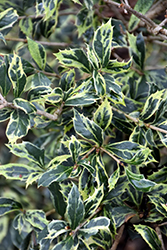It's all about ...
plants

Hamakita Shirofu Variegated False Holly
Osmanthus heterophyllus 'Hamakita Shirofu'
Height: 10 feet
Spread: 8 feet
Sunlight:
![]()
![]()
Hardiness Zone: 7a
Other Names: Tea Olive, Olive Holly, Holly-Leaf Osmanthus
Description:
This cultivar is similar in looks to holly, but it's actually related to lilac and privet; beautiful cream variegated, dark blue-green leaves are quite ornamental; flowers are subtle, but extremely fragrant, blooming in the fall; more adaptable than holly
Ornamental Features
Hamakita Shirofu Variegated False Holly's attractive spiny pointy leaves remain bluish-green in colour with showy creamy white variegation and tinges of chartreuse throughout the year on a plant with an oval habit of growth. It features subtle fragrant white flowers along the branches from late summer to early fall.
Landscape Attributes
Hamakita Shirofu Variegated False Holly is a dense multi-stemmed evergreen perennial with a shapely oval form. Its medium texture blends into the garden, but can always be balanced by a couple of finer or coarser plants for an effective composition.
This is a relatively low maintenance plant, and is best cut back to the ground in late winter before active growth resumes. Gardeners should be aware of the following characteristic(s) that may warrant special consideration;
- Spiny
Hamakita Shirofu Variegated False Holly is recommended for the following landscape applications;
- Accent
- Mass Planting
- Hedges/Screening
- Topiary
Planting & Growing
Hamakita Shirofu Variegated False Holly will grow to be about 10 feet tall at maturity, with a spread of 8 feet. Although it is technically a woody plant, this slow-growing plant can be expected to behave as a perennial in our climate if planted outdoors over the winter, usually regrowing from its base (crown) the following year. As such, gardeners should take into consideration that it will perform differently than it would in its native habitat.
This plant does best in full sun to partial shade. It prefers to grow in average to moist conditions, and shouldn't be allowed to dry out. It is not particular as to soil type or pH. It is highly tolerant of urban pollution and will even thrive in inner city environments. This is a selected variety of a species not originally from North America.
This plant is not reliably hardy in our region, and certain restrictions may apply; contact the store for more information.
